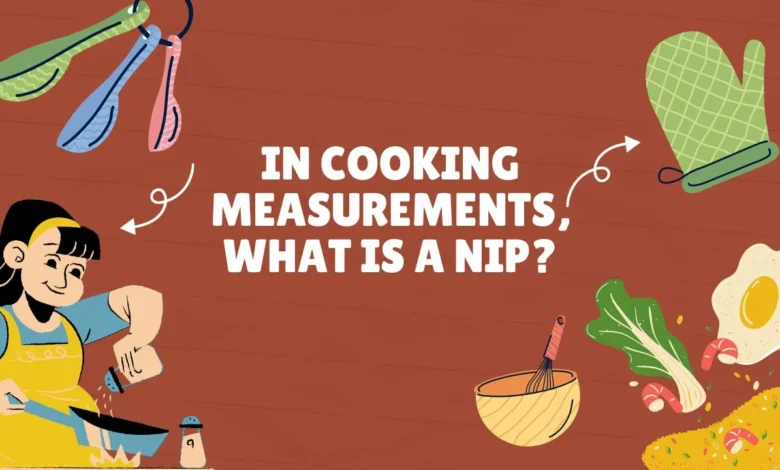In Cooking Measurements What Is a Nip?

Cooking involves many different measurements, and sometimes these terms can be confusing. One such term is “nip.” Many people wonder, “In cooking measurements, what is a nip?” Understanding this term is important for anyone who enjoys preparing recipes that use it. This article will explain what a nip is, its use in cooking, and its comparison with other measurements.
What Does “Nip” Mean in Cooking?
A nip is a small amount used in cooking, mainly when dealing with liquids. It’s a traditional term that has been around for a long time but is not commonly used in all recipes today. The term is most frequently found in older cookbooks and certain regional recipes.
How Much Is a Nip?
A nip generally equals 1/8 of a fluid ounce or about 3.7 milliliters. This measurement is smaller than a teaspoon, which is about 4.9 milliliters. So, if you see a recipe calling for a nip of a liquid ingredient, it’s asking for just a tiny amount, even less than a teaspoon.
Why Use the Term “Nip”?
The term “nip” is used when only a small amount of an ingredient is required. For example, if you want to add just a hint of flavor without overpowering the dish, you might use a nip of an ingredient like vanilla extract or a strong liquor in a dessert.
How Does a Nip Compare to Other Measurements?
When cooking, it’s useful to compare a nip to other measurements to understand its size better. Knowing this can help you substitute ingredients accurately if you don’t have a measuring tool for such a small amount.
How Does a Nip Compare to a Dash and a Pinch?
A nip is slightly more than a dash but less than a teaspoon. Here’s a quick comparison:
- Dash: A dash is typically considered 1/16 of a teaspoon.
- Nip: A nip is around 1/8 of a fluid ounce or 3.7 milliliters.
- Teaspoon: A teaspoon is 4.9 milliliters.
These small measurements are often used in recipes to add a subtle touch of an ingredient.
When to Use a Nip Instead of a Teaspoon?
A nip is perfect when you need just a hint of flavor. If a recipe is delicate or you are adding a strong ingredient, using a nip can prevent the flavor from becoming overwhelming. For instance, adding a nip of peppermint extract to a drink can enhance its flavor without overpowering it.
In Cooking Measurements What Is a Nip: Ingredients Measured in a Nip
Some ingredients are usually measured in nips due to their strong flavors or high potency. Using just a small amount can make a big difference in the taste of your dish.
Which Ingredients Are Measured in Nips?
Here are some common ingredients that are often measured in nips:
- Extracts: Vanilla, almond, or peppermint extract.
- Alcohol: Whiskey or brandy in cooking or baking.
- Spices: Hot sauces or liquid spices.
These ingredients are potent, and using more than a nip might overwhelm the dish.
Why Use a Nip for These Ingredients?
Using a nip for these ingredients helps control the flavor. Since they are strong, even a small amount can impact the taste significantly. It’s a good idea to start with a nip and adjust the amount as needed.
How to Measure a Nip Without a Measuring Tool?
If you don’t have a specific tool for measuring a nip, don’t worry. There are easy ways to measure a nip using common kitchen tools or even your judgment.
What Can Be Used Instead?
You can use a measuring spoon or even an eyedropper to get close to a nip. Here’s how:
- Measuring Spoons: If you have a 1/4 teaspoon, use half of it.
- Eyedropper: Use an eyedropper to measure around 20 drops, which is roughly a nip.
These tools are usually found in most kitchens, making them convenient alternatives.
Why Is It Important to Measure a Nip Correctly?
Even though a nip is a small amount, it can significantly impact the taste of your dish, especially with strong ingredients. Measuring correctly ensures your dish turns out just as the recipe intended.
What Is the History of the Term “Nip”?
The term “nip” has been around for centuries, and it has an interesting history. Understanding its origin can give us more insight into its usage today.
Where Did the Term Come From?
The term “nip” comes from Old English, meaning a small quantity. It was commonly used in recipes from the 19th and early 20th centuries, particularly in regions with a strong tradition of home cooking.
How Has the Use of “Nip” Changed Over Time?
Over time, the use of “nip” in recipes has decreased, replaced by more standard measurements like teaspoons and milliliters. However, it is still found in some traditional recipes and cookbooks.
Why Is Understanding a Nip Important for Cooks?
Knowing what a nip is and how to use it can be very useful, especially if you love cooking or experimenting with old recipes. It helps in achieving the right balance of flavors.
How Does It Affect the Recipe?
Using the correct amount is essential for the recipe to turn out as expected. Too much of a strong ingredient can ruin the dish, while too little might not have any effect at all.
When Should You Pay Attention to Nips in Recipes?
When following a recipe that specifies a nip, it’s important to measure it accurately. This is particularly true for desserts, cocktails, and dishes with complex flavors.
In Cooking Measurements What Is a Nip: Pros and Cons of Using
| Pros | Cons |
|---|---|
| Helps control strong flavors | Difficult to measure without proper tools |
| Useful for potent ingredients | Not commonly used, so less familiar |
| Adds subtle flavor without overpowering | Can be confusing for beginners |
| Enhances the taste with minimal quantity | Often omitted in modern recipes |
How to Substitute a Nip in a Recipe?
Sometimes, you may not have the exact tool to measure a nip. Knowing how to substitute can save your recipe and make cooking easier.
What Are Some Common Substitutes?
If you don’t have a tool to measure a nip, you can use a few other methods to approximate the quantity.
- Half of a 1/4 Teaspoon: This is roughly the same as a nip.
- 20 Drops from an Eyedropper: This can work well for liquids.
- Pinch of Powdered Ingredient: For spices or other powdered ingredients.
These substitutions should give you a close approximation if you don’t have a tool to measure a nip.
When to Use Substitutes?
Use substitutes when you don’t have the exact measuring tool but want to maintain the recipe’s integrity. Just be cautious and add small amounts at a time to avoid overpowering your dish.
Conclusion: In Cooking Measurements What Is a Nip
Understanding “in cooking measurements what is a nip” can make a big difference in your cooking, especially with recipes that call for precise amounts of strong ingredients. While not as common today, knowing how to measure a nip can help in achieving the right flavor balance in your dishes. By following this guide, you can confidently use a nip in your cooking and even substitute it if needed. Happy cooking!




